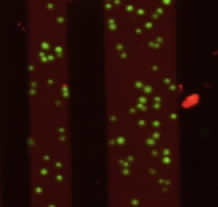Bioengineering, Tissue Engineering, Stem Cells, Biomaterials & Materials Research
 Degradable polymeric nanoparticle
Degradable polymeric nanoparticle HEK293 cell transfected with nanorods
HEK293 cell transfected with nanorods Spatial control over cell binding on degradable polymer substrate
Spatial control over cell binding on degradable polymer substrate
The replacement of tissues and organs with synthetic materials has become an increasingly important therapeutic modality and raises important questions about tissue response to a variety of substances. In dentistry, the clinical use of dental implants has intensified interest in collegiate faculty research, which examines changes in implant surfaces that may affect the attachment of soft tissue to implant surfaces, facilitate integration of a prosthesis with bone, or address the relationship between osteoporosis and oral health. Technologies and applications that involve biomaterials and tissue engineering. Applications include: restorative material adhesion, osseous tissue reconstruction, tooth replacement therapies
- Dr. Brad A. Amendt
- Dr. Amendt's research focuses on studying the expression and regulation of transcription factor genes and signaling processes involved in craniofacial/tooth development, the molecular basis of selected human genetic disorders, and the role of stem cells and microRNAs in regulating craniofacial and regenerative medicine.
- Dr. Maged Abdelaal
- Dr. Steven Armstrong
- Dr. Armstrong's primary research focus is adhesion of restorative materials to enamel and dentin.
- Dr. Gustavo Avila-Ortiz
- Alveolar bone, including understanding healing dynamics based on local and systemic individual patient features; analysis of site-specific factors that determine bone quality; evaluation of therapeutic strategies to prevent alveolar ridge resorption after tooth loss; implant site development techniques, in particular, sinus floor elevation.
- Dr. Jeffrey Banas
- Dr. Banas's broad research interest is the understanding of the pathogenic mechanisms of bacteria. Much of his work has focused on the microbiology of dental caries. His lab has extensively studied how the glucan-binding proteins (GBPs) synthesized by Streptococcus mutans contribute to the development of the plaque biofilm and ultimately dental caries. Since glucan -- a polymer of glucose derived from the metabolism of sucrose -- is a primary virulence factor that propels the change in microbial ecology that leads to a cariogenic plaque, it has been proposed that proteins that have the property of binding glucan play accessory roles in this process. It is now clear that the GBPs share in structurally supporting the biofilm, each doing so in a unique manner. These studies also revealed that the relative coverage of bacteria at the substratum surface of the biofilm was correlated with the risk of caries development. Dr. Banas's lab is also collaborating with College of Dentistry colleagues to investigate whether oral streptococci other than S. mutans are involved in the early stages of dental decay. Other collaborations, both within and outside the College of Dentistry, foster work to identify novel agents to specifically target cariogenic bacterial species, to coat dental materials with antimicrobials, to examine the microflora associated with localized aggressive periodontitis, and to investigate potential cariogenic properties associated with multiple bacterial species common to dental plaque.
- Dr. Christopher Barwacz
- Dr. Barwacz's areas of research include human clinical translational research in dental implant therapy; peri-implant crevicular fluid cytokine and bone-mediator expression; peri-implant mucosal esthetics; implant-abutment biomaterials and surface topography; minimally-invasive, microscope-based dentistry; dental ceramics; and translational human in-situ caries model research.
- Dr. David Bohnenkamp
- Dr. Piriya Boonsiriphant
- Dr. Boonsiriphant's research is focused on ceramic materials for dental applications.
- Dr. Kim Brogden
- Dr. Brogden's research focuses on the ability of peptides in saliva (defensins, histatins, etc.) to serve as downstream suppressors of cytokine signaling to recombinant hemagglutinin B (HagB) from the periodontal pathogen Porphyromonas gingivalis. In his work, they have found that human β defensin 3 (HBD3) has the capacity to influence the chemokine and cytokine responses of human dendritic cells: the timing of HBD3 exposure and the concentration of HBD3 treaatment of dendritic cells were both important in the onset, magnitude, and composition of the dendritic cell response to HagB. The mechanism may involve binding of HBD3 to HagB: HBD3 binds to immobilized HagB via surface plasmon spectroscopy and via ELISA and HBD3 inhibits binding of rHagB via surface plasmon spectroscopy and via ELISA and HBD3 inhibits binding of rHagB to cells via confocal microscopy and immunoelectron microscopy. Future research will determine the extent to which defensins can suppress early events in inflammation, an exciting concept that could be exploited to develop therapeutics to prevent or treat a variety of oral mucosal infections, particularly where inflammation plays a role in the pathogenesis of disease and its long-term sequelae.
- Dr. Richard Burton
- Dr. Huojun Cao
- Dr. Azeez Butali
- Dr. Robert Cornell
- Dr. Isabelle Denry
- Ceramics for biomedical applications: development and characterization; characterization of dental ceramics: crystalline phases, microstructure, structure/properties relationships; development of dental ceramics with tailored properties; leucite-containing ceramics, zirconia-based ceramics; resorbable 3-D ceramic scaffolds for bone tissue replacement.
- Dr. Ana Diaz-Arnold
- Dr. Martine Dunnwald
- Dr. Dunnwald's research interests involve skin, epidermal development and regeneration, and orofacial clefts.
- Dr. Satheesh Elangovan
- Developing and testing biomaterials for the purpose of periodontal and bone tissue engineering. Other interests include studying the interactions between biomaterials and biomolecules such as proteins, as well as DNA.
- Dr. Steven Fletcher
- Dr. Kirk Fridrich
- Dr. Lily T. Garcia
- Dr. Garcia's research interests include the evaluation of loading protocol on implants placed in grafted and non-grafted host bone sites, exploring teaching methodologies such as evaluation of a pilot PBL project in removable prosthodontics preclinical curriculum, evaluating mandibular denture retention with and without adhesive, and evaluating and utilizing new technology to record movement of prostheses intraorally.
- Dr. Carolina Garcia Martinez
- Dr. David Gratton
- Dr. John Hellstein
- Dr. Ryan Hill
- Dr. Julie A. Holloway
- Dental ceramics and dental implant materials sciences.
- Dr. Nathan Holton
- Dr. Liu Hong
- Adult stem cell-based craniofacial tissue engineering, including stem cell biology, in vitro and in vivo bone, cartilage and adipose regeneration, MR monitoring of engineered tissues.
- Dr. Georgia K. Johnson
- Effects of tobacco products on periodontal host response and the impact of smoking on periodontal treatment outcomes; the role of naturally occurring antimicrobial peptides in periodontal disease and clinical dental implant research.
- Dr. Theodoros Katsaros
- Dr. Katsaros participates in clinical research; his interests include the evaluation and comparison of different materials and techniques used for guided bone regeneration and post-extraction ridge preservation..
- Dr. John Keller
- Biological responses to biomedical materials, especially implants and bone substitute materials; characteristics of implant surfaces; mechanics of implant retention.
- Dr. Douglas Kendrick
- Dr. Terry Lindquist
- Dr. Lindquist's areas of research include material wear and dental materials.
- Dr. Peter Lund
- Dr. Lund's research includes dental materials; color in dentistry (color and translucency of dental materials and oral tissues, color measurement methodology; instrumental shade determination); evaluation of prosthodontic clinical techniques; implant prosthodontics; and education research.
- Dr. Carrie McKnight
- Dr. Lina Moreno
- Dr. Moreno-Uribe's research interest focuses on performing a genome-wide search for genes that affect growth of the human face using whole genome association methods and the latest technology for facial imaging. She wants to identify genotype-phenotype correlations that contribute to the development of an individual's maxillo-mandibular complex. This knowledge will likely result in development of an individual's maxillo-mandibular complex. This knowledge will also likely result in the development of novel orthodontic and maxillofacial therapies that will benefit our patients.
- Dr. Rodrigo Rocha Maia
- Dr. Aliasger Salem
- Dr. Salem's research interests are primarily focused on self-assembling systems, the rational design of novel drug and gene delivery systems and on the development of sophisticated scaffolds for tissue-specific regeneration. In tissue engineering, Dr. Salem's laboratory applies microfabrication techniques to novel biomaterials to provide spatial control over tissue formation and to integrate minimally invasive scaffold delivery strategies. In drug/gene delivery, he is currently exploring the synergistic application of degradable particle technology, CpG oligonucleotides and heat shock proteins for generating sustained immunotherapeutic responses against cancer.
- Dr. Galen Schneider
- Bone cell biology as it relates to implant osseointegration and bone tissue engineering. His research interest focus on several questions: 1. How does osteoblast cell adhesion regulate bone growth at the molecular level? 2. Does implant surface microtopography influence osteoblast differentiation? 3. Can bone tissue be engineered using injectable scaffolds? 4. Can three-dimensional environments be used for osseous tissue engineering?
- Dr. Kyungsup Shin
- Dr. Thomas Southard
- For over twenty-five years, Dr. Squier's research has focused on the structure and function of stratified squamous mucosae, with particular regard to the nature of the superficial permeability barrier structure and the role of topical carcinogens and micro-organisms in the pathogenesis of local and systemic disease. Specific areas of interest have been interactions between alcohol and tobacco components in the development of oral cancer and the mechanisms by which Staphylococcae and their toxins are involved in the vaginal pathogenesis of toxic shock syndrome. More recently, he has been concerned with the role of oral health professionals in assisting their patients with tobacco cessation. Dr. Squier has published more than 200 books, chapters, and peer-reviewed articles.
- Dr. Kyle Stein
- Dr. Hongli Sun
- Dr. Sun's research seeks to develop novel biomaterials-based strategies to improve challenged bone (e.g. large, aged or irradiated bone defects) tissue regeneration by mimicking the natural bone healing process. We are particularly interested in understanding the underlying the mechanisms by which osteogenic differentiation of the resident adult stem cells is regulated by the microenvironmental cues during tissue injury and repair. Inspired by these fundamental findings, we are devoted to developing novel nano-biomaterials/drug delivery-based translational strategies for tissue engineering and regenerative medicine. Our long-term goal is to develop novel therapeutics for musculoskeletal related diseases, including large bone defects, vascular ossification, and cancer bone metastasis.
- Dr. William Synan
- Dr. Erica Teixeira
- Dr. Teixeira's research focuses on the development and evaluation of biomaterials and their application to dental public health. Specific areas of interest are mechanical behavior and surface modification of ceramic materials. In addition, her research involves the effect of new techniques/technologies on the interface between tooth and direct and indirect restorative materials.
- Dr. Fabricio Teixeira
- Dr. Eric Van Otterloo
- Dr. Jin Xie
- Dr. Xie's research focuses on biostatistics and research design.